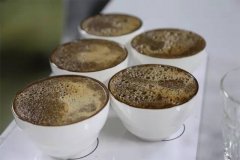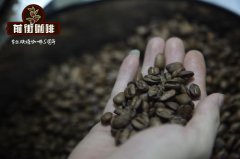Does the Gold Cup Rule apply to Italian coffee? How to judge whether espresso coffee is under-extracted or over-extracted
When making coffee for the first time, the appearance of oil has almost become the only criterion for judging whether the extraction is good or not. Many friends who use coffee utensils other than Italian machines always struggle with the fact that their coffee is free of oil. Does only espresso coffee have grease? Why does the mocha pot have so little espresso oil? What kind of grease is the perfect Espresso?
Affect the formation of Espresso coffee oil
A standard Espresso is only about 1 ounce and is covered with a thin layer of foam called "Crema" (Crema). The more detailed the Crema foam, the better, much like a layer of colored cream, the color is close to crimson dark brown, if you see a layer of golden foam, it is probably that the coffee beans are not fresh enough, this kind of Espresso is not thick. In addition, the thickness of Crema should be at least 10% of that of coffee, and it can last for more than three minutes without cracks.
People who like to drink Espresso regard Crema as an indicator of quality. Secondly, it is composed of the same large group of small foams, and the structure of each small foam is surrounded by a layer of water-based film around carbon dioxide. Of course, fresh coffee has more carbon dioxide inside, and espresso brewed with it will also contain more Crema, which makes it feel "as soft as a swan". The water-based film contains a large amount of water, which will be released very quickly, so that the film can not be supported and break, and the Crema will disappear. No wonder Italians always wait at the bar and drink a glass of Espresso in 30 seconds.
It is easy to produce a crimson Crema using Espresso with the Robota bean formula. Although high-quality robusta beans can increase the mellow thickness of Espresso, improper use will produce fishy coffee. Therefore, a good Espresso must have a rich Crema, but a rich Crema is not necessarily a good Espresso. Factors affecting the formation of ESPRESSO lipids
Velocity of flow
The flow rate of Italian coffee directly determines the taste of ESPRESSO, too fast flow rate will make the essence of coffee has not been dissolved into the water, but the water has passed through the coffee powder, resulting in coffee tasteless; too slow flow rate will make the essence and dross of coffee all into the water, resulting in coffee with obvious scorching taste or exciting bitter taste.
For beginners, the flow rate control is a quantitative standard, generally we take 22 seconds to 28 seconds as the best value.
The more advanced ones will judge the flow rate by the shape of the water flow when the coffee is extracted. Foreign baristas like to use the mouse tail to describe the flow rate of coffee.
The higher level is that the flow rate of coffee is determined by its taste. If the flow rate is faster, the taste will be single but refreshing, and the sour taste will be heavier; if the flow rate is slow, it will increase the mellowness, and the more complex but bad taste will be released at the same time. The bitterness will be a little heavier.
The speed of the flow rate is a dynamic process, no barista or any kind of coffee equipment can guarantee the consistency of the coffee flow rate, and even the humidity of the weather will affect the speed of the coffee flow. So baristas must know that it is easy to control the flow rate rather than being controlled by it.
Thickness
The thickness of ESPRESSO grease is a very complicated problem, which is much more complicated than the color of grease. The thickness of the grease is essential for making a real cappuccino and the popular coffee flower, so the rich and long-lasting grease can be said to be an important sign of high-quality ESPRESSO. The grease of ESPRESSO is not really a layer of "oil" floating on the surface of coffee, but is composed of delicate bubbles, so when we study the thickness of grease, we should not only look at how thick it is, but also observe how long it can last. The thickness of oil generally has a lot to do with the freshness of beans. If the beans are too fresh, the extracted oil will be very thick, but it will dissipate very quickly. We think that this kind of oil is too rough. Therefore, bean cultivation plays an irreplaceable role in the formation of oil. Only beans raised correctly can extract long-lasting oil. Although the fat is too thick is not necessarily a good thing, but if the oil is too thin, it must be a bad thing, generally due to: beans stored for too long or improper preservation; too little powder; grinding too coarse or too fine; extraction time is too long or too short; the flow rate is too large; improper filling pressure and other reasons. Generally speaking, I personally think that a serving (1 ounce) of ESPRESSO is a sign of high quality oil with a duration of at least 2 minutes.
The color of Italian coffee oil is preferably golden yellow and slightly brown, and the color of oil is milky white, which is generally called underextraction, while the preference for dark brown is excessive extraction.
Insufficient extraction
The lack of extraction is generally reflected in the milky white color of the oil, which may be due to insufficient powder, too light filling force, too low water temperature, too coarse coffee powder, insufficient water pressure or not fresh coffee beans. sometimes it is also related to the light roasting of coffee beans or the variety of coffee beans.
Excessive extraction
Excessive extraction is generally reflected in the dark brown color of the oil, which may be caused by too much powder, too much filling force, too high water temperature, too fine grinding of coffee powder and other reasons, sometimes it has something to do with the excessive roasting of coffee beans.
The grease color of espresso is the most basic knowledge that coffee lovers and baristas must understand and master, which can help you understand the quality of coffee in the shortest possible time.
Important Notice :
前街咖啡 FrontStreet Coffee has moved to new addredd:
FrontStreet Coffee Address: 315,Donghua East Road,GuangZhou
Tel:020 38364473
- Prev

What is the cup test often mentioned in coffee? what is its function?
The most direct way to express the quality of a cup of coffee is to judge the cup, which is a magical and simple sensory evaluation. Cup test is an evaluation method to eliminate the factors that affect the quality of coffee. Several different kinds of coffee were evaluated and compared at the same level. Through the cup test, we can test the original flavor of coffee beans and whether they are mixed with sundries and so on. In
- Next

The principle of operation in a baking machine
Professional coffee knowledge exchange more coffee bean information please follow the coffee workshop (Wechat official account cafe_style) roasting coffee converts the chemical and physical properties of raw coffee beans into roasted coffee products. The roasting process causes raw beans to expand and change their color, taste, smell and density, resulting in the special flavor of coffee. Unbaked coffee beans and roasted coffee beans contain
Related
- Beginners will see the "Coffee pull flower" guide!
- What is the difference between ice blog purified milk and ordinary milk coffee?
- Why is the Philippines the largest producer of crops in Liberia?
- For coffee extraction, should the fine powder be retained?
- How does extracted espresso fill pressed powder? How much strength does it take to press the powder?
- How to make jasmine cold extract coffee? Is the jasmine + latte good?
- Will this little toy really make the coffee taste better? How does Lily Drip affect coffee extraction?
- Will the action of slapping the filter cup also affect coffee extraction?
- What's the difference between powder-to-water ratio and powder-to-liquid ratio?
- What is the Ethiopian local species? What does it have to do with Heirloom native species?

